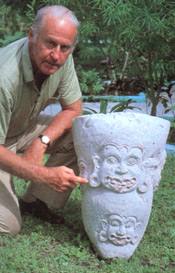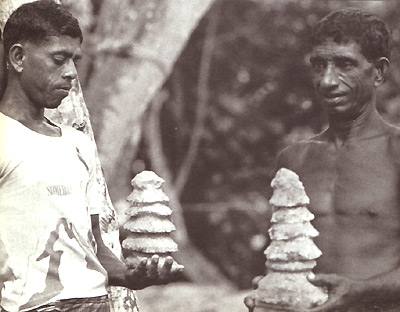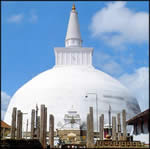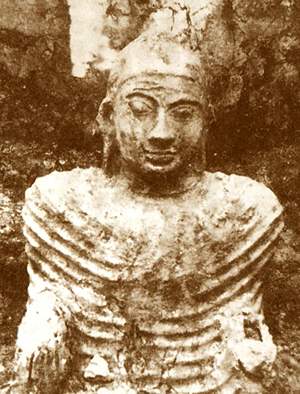| By: Xavier Romero-Frías
(author of the book ‘The
Maldive Islanders; a Study of the Popular Culture of
an Ancient Ocean Kingdom’, available at:
ethnoind@hotmail.com)

Heyerdahl with Maldive icon |
Since Heyerdahl published his 'Maldive
Mystery', many books, articles and guides about the
Maldives mention sun-worship, pyramids, waves of immigrants,
attacks by lion-people and other such fallacies in their
historical outline of the Maldive archipelago. These
distortions of truth are common in all of Heyerdahl’s
books, which are less about serious research than about
displaying himself and his wild theories as loudly a
film star would.
It is understandable that the writers of tourist guidebooks,
for example, would like to quote from as many sources
as they can. Tour guides try to give as much information
as possible, while keeping the book compact, and if
the historical information in those guides comes mainly
out of Thor Heyerdahl’s ‘The Maldive Mystery,’
it is not a coincidence or a preference of the author.
Considering that those guides are printed in great numbers,
being distributed throughout the world and taken as
reference by a wide public, we are dealing with a serious
anomaly concerning how Maldivian history, archaeology
and ethnology are being reflected and propagated by
the world media.

Ruined miniatures of satihirutalu which
formed the apex of the Maldive Buddhist usthumbu.
The usthumbu has three parts:
the quadrangular base representing earth; the
bell-shaped middle part, representing water;
and the satihirutalu representing air
which crowns the usthumbu.
The Dambidu Loamafaanu (copper plate document
circa 12th century) mentions the
knocking down of satihirutalu off usthumbu
as a deliberate act of disfigurement of Buddhist
sites by the then relatively new Islamic authorities.
In the more familiar Buddhist terminology of
countries other than the Maldives, usthumbu
is stupa and satihirutalu is chatravali

The above illustration
shows the Ruwanveliseya stupa in Sri Lanka-
a non-Maldive stupa.
In addition to representing air, the satihirutalu
also represents buddhi or enlightenment.
In modern Divehi, buddhi means wisdom.
Enlightenment leads to nivvaalun  in Divehi, nibbana
in Divehi, nibbana  in Pali and nirvana in Sanskrit. In Buddhist
parlance, nivvaalun means the extinction
of the life-affirming will manifested as greed,
hate, delusion, and convulsively clinging to
existence. In Buddhist doctrine, nivvaalun
is final bliss; absolute emancipation; ultimate
release from the cycle of rebirth and death,
old age and disease. Nivvaalun constitutes
the highest and ultimate goal of all Buddhist
aspirations. In modern Divehi, nivvaalun
means the extinguishing of a flame.
in Pali and nirvana in Sanskrit. In Buddhist
parlance, nivvaalun means the extinction
of the life-affirming will manifested as greed,
hate, delusion, and convulsively clinging to
existence. In Buddhist doctrine, nivvaalun
is final bliss; absolute emancipation; ultimate
release from the cycle of rebirth and death,
old age and disease. Nivvaalun constitutes
the highest and ultimate goal of all Buddhist
aspirations. In modern Divehi, nivvaalun
means the extinguishing of a flame.
|
Regrettably, not all the books that
give serious information about the Maldives are readily
available. H.C.P. Bell’s ‘The Maldive Islands’,
A. Agassiz’s ‘The Coral Reefs of the Maldives,’
C. Maloney’s ‘People of the Maldive Islands’
and ‘The Voyage of F. Pyrard de Laval to the East
Indies, The Maldives, the Moluccas, and Brazil’
translated and edited by A. Gray, are books which give
excellent and well-researched information on the Maldives,
but they are rare and difficult to obtain and they are
nowhere near to being as ubiquitous as T. Heyerdahl’s
‘The Maldive Mystery’ in bookstores and libraries
throughout the world. This anomaly becomes especially
acute when it comes to translations into other tongues.
There are many languages in the world where the only
book whose theme is Maldives is Thor Heyerdahl’s book.
The sad fact is that serious good books about Maldives
don’t sell, and thus are not known, while Thor Heyerdahl’s
books, which are nothing more than a caricature of history
and archaeology, are stuff that sells and, therefore,
have filled the void left by the lack of serious books
on Maldives.

Buddha at the Thoddu island temple |
Was it a blessing for Maldives that
Thor Heyerdahl came to write the last book of his series
on this coral atoll nation? It certainly has made the
country a bit more well-known than it was before. But
in the light of the distortions of reality inflicted
on the Maldive history that have been and are being
popularized by tourist guidebooks and are staying there
in print, it would have been better that Heyerdahl would
not have come at all.
One cannot deny that Thor Heyerdahl is a celebrity.
He rubs his fame to every place he has written a book
about. Therefore, the Easter Island and the Marquesas
would certainly be not so well-known if he would not
have been there. Like the Maldives, these are small
places and their only chance to make it to fame in the
world is being patronized by Thor Heyerdahl. But it's
better to be sceptical about him and his methods, especially
when one considers the fact that Heyerdahl has misused
the real anthropological and historical facts of those
islands in order to enlarge his own image. This misuse
is tantamount to abuse, for Heyerdahl was not an honest
archaeologist and one sure outcome of his meddling is
that he has made the job more difficult for future researchers
that will visit the places where he has left his deep
traces.
Here
is what Paul Theroux, an American travel writer
says about Thor Heyerdahl (and I wholeheartedly agree):
"Thor Heyerdahl is shrill but mistaken in many
of his assumptions. Far from solving the Easter
Island mystery, he has succeeded in making the
solution more difficult for qualified scientists
and made something of a fool of himself in the
process. He is an amateur, a popularizer, an
impresario, with a zoology degree from the University
of Oslo. And his efforts in the Pacific greatly
resemble the muddling attentions of, say, the
hack writer of detective stories when faced
with an actual crime scene --someone who ignores
the minutiae of evidence, hair analysis, or
electrophoresis (for typing bloodstains)-- and
in blundering around a crime scene, muttering
"The butler did it!", makes a complete hash
of it for forensic scientists. The mention of
Heyerdahl's name in academic circles frequently
produces embarrassment or anger..."
|
In the Maldives Heyerdahl thought he
saw sun-temples and pyramids in the mounds or low hills
that exist in certain islands. In all of his later publications
he refers to former books he wrote, in order to promote
their sales. But in fact all archaeological sites he
visited were ancient Buddhist Stupas. Since islanders
took away stones from those Stupas for building their
homes, when the round structure on top collapsed on
the quadrangular base, it left shapes that could be
said to be roughly conical or pyramidal.
The truth is that, as HCP Bell proved with his careful
and learned research work, all archaeological remains
on the Maldives unearthed to date are distinctly Buddhist.
And that the Hindu elements in those sites are not part
of a former substratum, but part of Buddhist iconography
itself, for Buddhism may be regarded as a branch
of Hinduism and both influenced each other mutually
(in their architecture, iconography, etc.) along their
history because their geographical and cultural origins are
mostly overlapping. Concerning archaeology in the Maldives, I
wish more people would read and refer to HCP
Bell's 'The Maldive Islands', which despite being old
is still the best work on the subject, instead of Heyerdahl's
book. Bell's book has been reprinted by Asian Educational
Services, asianeds@nda.vsnl.net.in
Another of Heyerdahl’s blunders concerns his insistence
that large groups of people bringing with them the sun-worship
had travelled the seas of the world in innumerable rafts
or crude boats, settling here and there and building
up new societies that built pyramids and decorated them
with sun-symbols. He badly wanted to believe that Asehkara,
the way Maldivians call the kingdom of Aceh in northern
Sumatra, was the land of the Aztecs, at the other end
of the world.
But the truth is that people didn't arrive to the Maldives
in masses, and not even in sizeable communities. The
most likely is that along the centuries, one person
here, another person there, kept adding up. The Maldivian
legends talk about some rulers or kingly people who
arrived to the islands, probably about 2,000 years ago.
But those may have only been a handful of people who
took power, or were given the right to rule, and later
intermarried. Mass migration of people from different
ethnic groups would have created an enduring trauma
that would necessary have been reflected in the oral
tradition.
After 24 years of gathering and studying the oral tradition
of the Maldive Atolls I can only say that Thor Heyerdahl’s
wild speculations are completely misplaced.

Temple site at Nilandu
The graphics except that of the
Buddha are from Heyerdahl, Thor: the Maldive
Mystery
|
|

